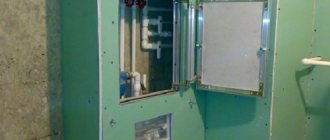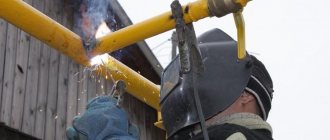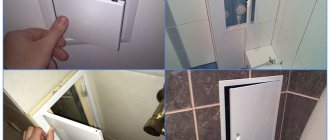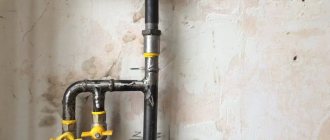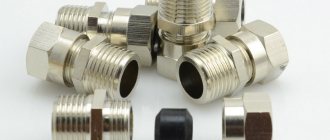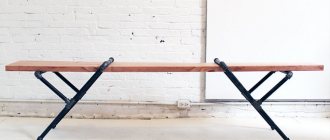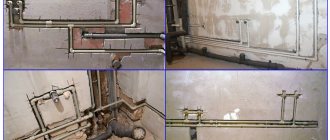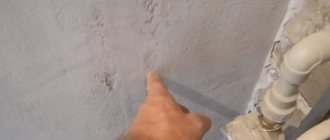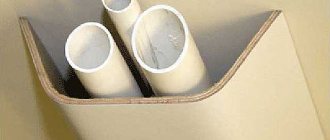One of the main concepts of modern renovation can be stated as follows: all communications should be invisible. Everything from wiring under drywall to water risers are hidden under trim or other means. But how to cover gas pipes with plasterboard, and is it possible to do this? You can hide it, but according to the rules and regulations for the operation of gas appliances, in no case should it be. At a minimum, gas pipes that are “tightly sealed with plasterboard” face a fine, and at maximum, a supply cutoff.
There are many options for solving this problem; everyone usually decides for themselves how the pipe with the riser will be hidden, but how to do this using plasterboard sheets?
Rules and regulations
When deciding how to hide a gas pipe, you need to take into account the requirements and standards for gas communications in the apartment.
- It is necessary to ensure free and quick access to the gas pipe in case of gas leakage if it is damaged.
- It is strictly forbidden to hide pipes in solid solid non-removable boxes and in grooves punched in the wall to avoid an explosion due to gas accumulated during a leak.
- Even when installing boxes that are easy to disassemble and provide good ventilation, you should coordinate your intentions with the gas services.
- It is prohibited to move gas pipes and metering devices on your own. This can only be done by specialists who have permission from the gas service.
- Communications can only be masked using materials intended for such work.
- Coloring is a must. It protects pipes from corrosion and extends their service life.
- When working with gas pipes, it is prohibited to attach heavy objects to them, thereby placing additional stress.
Safety during work, as well as during subsequent operation of gas equipment, should always remain a priority issue.
In what cases is it permissible to cover a flue with plasterboard?
The answer to the question whether it is possible to hide gas pipes under drywall is in the standards. It is necessary to follow safety precautions when erecting such structures, relying on paragraph 7 of SNiP 42-01-2002. According to the document, gas pipelines can be laid in open and closed ways.
- An open gasket involves providing free access to the gas duct, which is not sealed or sewn up.
- Concealed laying of the gas pipeline is permitted using removable structures. To do this, additional measures must be provided to protect it from corrosion, access to the pipeline for its maintenance, repairs and work. It is possible to hide the pipe behind plasterboard screens, covers, and casings. It can be sealed in a plasterboard case or hidden behind a partition. It is impossible to sew up the flue tightly
Coloring
The simplest, most affordable and inexpensive way to disguise pipes is to paint them. If you approach this matter creatively, communications that irritate the eye can be made completely invisible or, conversely, turned into a memorable element of decoration. The advantage of this method is that access to the pipe remains free, so gas services will not have any complaints against you.
The easiest way is to paint the pipes the same color as the walls, achieving the greatest shade match. A white pipe against a white wall becomes almost invisible.
Some people prefer to paint gas lines in contrasting colors. This solution is suitable for those kitchens whose design is dominated by rich, bright colors. It’s good if the color of the pipe matches some interior detail - curtains or kitchen furniture.
If the design of the room allows, communications can be painted with gold or silver paint, and also a geometric or floral pattern can be applied to them. You can paint the pipe in the form of a tree trunk, for example, a birch. To make this design look even more original and fit organically into the interior, you can draw several leaves nearby on the wall.
Traditional types of paints are used to paint pipes.
Simple (illegal) solutions and their risks
Simple, easy solutions to a problem often turn out to be wrong. This truth directly concerns those owners of an inconveniently located gas pipeline who seek to resolve the issue of how to decorate a pipe in the kitchen without familiarizing themselves with the requirements of SNiP.
When equipment becomes part of the styleSource dekorin.me
Popular thought has generated many ways to violate safety rules. Most often, the gas pipeline is closed in a blind box, and all control elements also go there. Such a box looks like a smooth rectangular column (pylon), often from floor to ceiling. It usually consists of a metal frame, which is covered with sheets of plasterboard without a hint of ventilation.
In a plasterboard boxSource szaman-meble.pl
If the gas workers of the service company do not neglect their duties and carry out regular inspections of the pipes, the owners of such a box will sooner or later earn a fine. More serious problems arise when the gas company reports violations (a common practice) to the state housing and architectural supervision service. In this case, the apartment will be inspected regarding illegal redevelopment, and then the owners will undergo regular inspections to avoid a relapse.
Stylish and practicalSource www.ivd.ru
It is not only the major camouflage of a gas pipeline that is considered illegal redevelopment. Hiding a gas riser in the wall will also most likely not be allowed. It is not only the rules and GOSTs that hinder the implementation of this method, but also the walls themselves. In panel and monolithic buildings, load-bearing structures have a reinforcement frame, damage to which violates the load-bearing capacity of the walls. Brick houses do not have a frame, but in order to determine how safe it is to carry out the work, an inspection by the design organization will be required.
How to beat a gas water heaterSource idei-dekoru.com
What seems attractive is the method of connecting the slab to the gas pipeline using a thin flexible hose that can easily be hidden in a hole. This option is also prohibited due to the low service life and reliability of the flexible line.
In exceptional cases, gas communications are allowed to be placed in the wall, but only a design organization can authorize work on moving the riser, and it can be carried out by an organization that has the right to do so.
Contrasting colors distract from technical detailsSource freelancehack.ru
Decoration options
Some, in pursuit of originality, decorate pipes by covering them with glass balls using Moment glue. Some people make a tree trunk out of a pipe, wrapping it with twine and decorating it with leaves cut out of green plastic.
Another option is decoupage style disguise. How to close a gas pipe in the kitchen using this method?
- The surface is carefully cleaned, freeing it from old paint, grease and dirt.
- Spread a paper or fabric napkin with PVA glue and separate the top layer with the pattern.
- Apply it to the pipe and gently smooth it out.
- The top is again coated with glue.
- When it dries, cover everything with varnish.
Some people simply close the pipe by hanging it with magnets.
Is it possible to hide gas pipes under drywall?
The kitchen is traditionally a receptacle for heating, gas, water and sewer pipes, which are constantly in sight, thereby violating the integrity of the interior of the room.
The main problem is gas pipes, since hiding them in grooves is prohibited by operational rules. Modern building materials can provide assistance, the most popular of which is plasterboard.
Its versatility and ease of processing makes it possible to hide a gas pipe in the kitchen effectively and stylishly.
What is railing
A rail is a metal rod attached to the wall. With the help of a variety of hooks, holders and shelves, it is easy to place various kitchen utensils on it - a ladle, a colander, pot lids, towels, etc. The proposed method is to create the appearance that the gas pipe running along the wall is actually the railing that the designer intended. For this purpose, the pipe is painted so that it matches the color of the railing as closely as possible, which usually has a shade of bronze, copper or is made of chromed metal.
The railing is installed directly under the pipe and various kitchen utensils are hung on it. A pipe located close to the railing and matching it in color will create the illusion that it is a part of the overall system.
Nuances of work: how to close heating pipes in a plasterboard room
In any residential or non-residential premises there are pipes that provide warmth in the autumn-winter period. Of course, their appearance leaves room for improvement.
There are several ways to hide thermal communications:
- Sew the radiator and heating pipes into the wall;
- Hide the pipes using a box;
- Create a false wall.
The most popular and fastest method is to install a box. This method works well if the room has already been renovated. The work is similar to that described above, taking into account one nuance.
Radiators and heating pipes must give off heat, and if they are covered with plasterboard, the heat flow will remain directly in the box.
Special holes in the front of the box will help solve this problem. You can make these holes using an electric drill. You should install a special nozzle on it and calculate the required number of holes. The quantity and diameter can be any. The market also offers its customers special covers that can be mounted in a box to perform several functions.
Namely:
- Give the structure an aesthetically complete look;
- The built-in grille allows air to circulate normally.
After installing the box, it should be decorated in any way you like. This method of masking a heating system is the simplest and does not require special skills or dexterity. To do this, you should strictly follow the step-by-step instructions and recommendations of specialists.
How to hide a horizontal pipe
A horizontally located gas communication, laid high enough, can be hidden by installing a wide shelf under it. Once various kitchen utensils are placed on it, the pipe will no longer be noticeable at all, especially if you paint it to match the color of the wall. Of course, the shelf should be installed in compliance with all safety measures so as not to damage the gas pipeline.
If you place kitchen cabinets instead of a shelf, the pipe will be even less noticeable. The cabinets are deeper than the shelves, so the gas pipeline will be practically invisible from below. With this method, all safety rules are observed - free access to communications and sufficient ventilation.
How to avoid mistakes - advice from the experts
To avoid unpleasant consequences as a result of independent actions with gas communications, possible penalties, we should not forget about safety. Before work, they become familiar with the rules so that the planned actions do not contradict them.
There are not many requirements, it won’t be difficult to adhere to:
- fastening of any products, including the railing option, is carried out on walls, and in no case on pipes;
- all structures are removable or with a door or panel that provides quick access to devices;
- blind boxes in which gas can accumulate during a leak are prohibited;
- the gas water heater is hidden behind the casing, provided that powerful ventilation is provided;
- All materials except gypsum are allowed for use.
The geyser is hidden in a cabinet with a door and has a reliable hood.
According to the standards, the location of pipes and meters is carried out in the most visible and accessible places. The approach to the equipment cannot be hampered by any obstacles in order to make emergency gas shutoff or repairs if necessary. This is laid down in the rules and must be followed unquestioningly. There are many options for masking gas communications, but one should not forget about safety for the sake of decorativeness.
Using furniture for camouflage
Using furniture installed in the kitchen, you can hide not only pipes located both horizontally and vertically, but also gas equipment - meters and even dispensers.
For this purpose, you can order a special false cabinet or remodel an existing kitchen set. Holes for pipes are made on the back wall of the cabinet, as well as on its top and bottom surfaces. To hide the gas riser, a pencil case is usually used. Horizontal pipes are hidden in a regular cabinet. Inside the cabinet, which hides the gas pipeline, you can store various kitchen utensils. The main thing is that this cabinet should be well ventilated, so for ventilation in the most inconspicuous places you will need to make several holes or install a grill and in the future make sure that they are not covered by jars and pans.
The design of the furniture hiding the pipe should provide quick and easy access to communications.
Prohibited tricks
There are a number of camouflage techniques that cannot be used. Let's highlight the general rules and talk separately about each group of communications.
- Communications cannot be laid in a load-bearing wall. Any work on a load-bearing wall that involves reducing its strength must have a basis in the form of an accurate calculation and permission from the BTI.
- It is better not to lay communications directly in the walls, this will significantly complicate the detection of leaks and can lead to unpredictable processes in the partitions. An unpleasant odor may appear, the wall may crumble, or an unclear leak may occur. To eliminate the consequences, you will have to dismantle the entire partition, which is associated with high costs.
- Some communications cannot be transferred. This is primarily due to heating. The radiator is installed in accordance with hydraulic calculations and SNiP requirements. Therefore, it is better to simply hide it than to move it to a more convenient place. Also, without professionals, you cannot move gas pipes and change the position of the gas stove. This is all due to the same hydraulics and the position of the ventilation ducts.
Sewerage and gas supplies cannot be hidden in the walls. They can only be painted or closed with boxes. These communications must be in constant direct access for repairs.
Box structure
All of the above methods only allow you to disguise the pipes. If you want to completely hide their presence, you can build a box. The material for such a box is usually plasterboard, plywood, plastic or MDF. In this regard, many are interested in: is it possible to cover gas pipes with plasterboard? It is possible, but subject to the following conditions:
- The box should not be monolithic. If necessary, access to communications should be provided in the shortest possible time. Therefore, at least part of the box should be disassembled easily and quickly.
- An indispensable condition is the installation of ventilation in the box in the form of perforations or grilles. In its absence, gas, even with a small leak, will accumulate inside the box, which will lead to catastrophic consequences.
Failure to comply with these requirements will entail a risk to the life and health of the inhabitants of the apartment, as well as fines from the gas service.
Examination
Upon completion of all installation work, the entire system is checked for leaks and general performance.
In general, you need to check the following questions:
- The system is ready to function, that is, everything must be tightened, everything connected, and so on;
- No fuel leakage in all components and connections.
The test is carried out the old way - using a regular soap solution. It is applied with a brush to all connections. If bubbles appear after application, then we can say that there is a leak. This connection is made poorly and requires reworking.
It should also be noted that all changes are made to the premises passport. Contributions can be made only on the basis of the act, which was discussed a little higher.
A blue flame can bring comfort and coziness to every home. Not a single housewife who prepares food can do without it. However, the use of gas is often associated with risk, and the safety of all its inhabitants depends on how competently the installation of the gas system in the house is carried out. That is why the transfer of gas pipes and all other installation work of the gas supply system is best left to professionals.
Box material
What material is better to choose for constructing a box? Currently, the most popular material for these purposes is drywall. Is it possible to cover gas pipes with plasterboard? Yes, you can. This material is characterized by advantages that make it indispensable for these purposes:
- it is a heat and waterproofing material;
- it can be bent, which makes it possible to create rounded shapes;
- lightweight, which means it is perfectly suitable for the construction of removable structures;
- it can be painted to match the rest of the interior, as a result of which the box becomes, as it were, an integral part of it.
To construct the box, it is better to use fire-resistant types of drywall.
One of the disadvantages of such a box is the reduction in the usable area of the kitchen, so gas pipes are usually hidden under drywall in spacious kitchen areas.
Another disadvantage of drywall is its inability to support a lot of weight. Therefore, when wondering whether it is possible to cover gas pipes with plasterboard, decide in advance whether you are going to hang shelves on the box or install a TV.
How to hide communications behind a false wall
It also happens that the pipes in the kitchen are located along the wall completely chaotically, and are not collected in one specific place. In this case, it makes no sense to make a box for each pipe, but communications can be hidden using a false wall. Here you need to take into account that such a design will take up some space in the room, so owners of kitchens with a small area should think twice before creating a false wall.
As in the case of a box, such a wall can be made from different materials: plasterboard, chipboard, plywood, wooden boards, plastic. The process of installing a false wall is not much different from assembling a box. The stages of work here are almost the same, only the frame needs to be built across the entire wall.
Instead of a false wall, you can use a special screen to mask the pipes. Fortunately, such designs are sold ready-made and have a wide range. Screens can be made of glass, metal, wood, plastic and other materials. They also vary in appearance: made in the form of latticework, arches, columns, etc. Depending on the type of construction, there are screens of hinged and flat types, as well as screens in the form of an attached box.
Box installation
Depending on the location of the pipes, the box can be vertical or horizontal. To install a plasterboard box for gas pipes you will need:
- moisture-resistant drywall;
- profile or slats for the frame;
- screwdriver;
- self-tapping screws;
- metal scissors.
How to properly cover a gas pipe with plasterboard? The algorithm of actions in this case is as follows:
- First you need to calculate the size of the structure. The distance from the pipes to the frame must be at least ten centimeters. It is also necessary to take into account the need for free access to the taps on the gas pipe.
- The frame is installed. The profile or slats are attached to the wall with self-tapping screws.
- The resulting structure is measured and a sheet of drywall is marked. The details of the future box are cut out of it.
- They are secured to the frame with self-tapping screws using a screwdriver. Irregularities are puttied, cracks are sealed with polyurethane foam.
- To access the faucet or meter, plumbing hatches are installed in the drywall.
- The box is primed, and then painted to match the walls, covered with wallpaper or decorated using decoupage.
Thus, the question of whether it is possible to cover gas pipes with plasterboard depends only on the availability of the space required for this design and on compliance with safety requirements.
Work algorithm
Almost any plasterboard product is assembled on a frame, which is then sheathed with material. The walls around the gas pipe must first be prepared and marked. All old trim and furniture must be removed, cleaning all surfaces. If there are dilapidated and fragile areas, they need to be restored. After that, they begin to mark the lines where the guide profile will be mounted, from which the base will be assembled.
The process of marking a wall for installation of a plasterboard box
- According to the markings, the CD guide profile is fixed, through which holes are drilled for mounting dowels-nails. The spacing of the attachment points is 250–300 millimeters. It is worth remembering that the type of dowel is selected according to the wall material. If they are made of soft aerated concrete, then so-called “crocodiles” are needed.
- Rack profiles cut to the required sizes are inserted into the guides and they are connected together with clamps.
- The external corners are again made from UD guide profiles, connecting two at a time, with shelves facing each other. Small metal screws are suitable for fastening. Diagram of an external corner for a plasterboard box
- Corner guides are mounted to the racks, connecting along the way with bugs.
- To ensure the rigidity of the entire box, it is worth inserting several transverse (or rather, longitudinal profiles). They are cut to size and the side shelves are cut to the required length. These parts are also attached to the resulting structure with self-tapping screws.
- To fasten hatches or doors in order to have access to the inside of the box, wooden inserts can be placed in the guide rails; they are fixed with self-tapping screws or press washers.
An example of fastening a door in a plasterboard box - Drywall is cut to the size of the edges of the resulting box and attached to the frame. When screwing in self-tapping screws, you need to control the pressing force on the screwdriver so that the head of the fastener does not break through the cardboard. But, in this case, the attachment points should be slightly “recessed” into the surface by 1–1.5 mm.
Attaching drywall to a false wall frame in the kitchen - The joints between the sheets are puttied and glued with sickle tape. You need to putty all the places where the screws are screwed in. When the plaster mixture has dried, it is sanded with sandpaper with a grain size of 120–160.
- Next, you need to glue the profiled corners on the edges of the box and plaster the entire surface. Such a box will be ready for decorative finishing after finishing grouting the dried plaster mixture.
Watch the video: how to hide pipes in a drywall box.
Thus, niches are also assembled onto horizontal pipelines, leaving the lower planes uncovered. After decoration, such a box will fit very well into the overall design of the kitchen, hiding communication lines.
Why do the pipes look so intricate?
This is exactly the question that arises in your head when you once again see the strange arrangement of gas lines in the kitchen. The explanation is simple: pipes are laid exclusively according to standards, observing the height from the floor, the distance to gas appliances and many other factors. Therefore, an amazing gas pipeline design in your kitchen is not the desire of gas workers, but sometimes the only right solution to comply with standards.
When will a pipe interfere with siding?
Before figuring out how to solve a problem, it’s worth finding out whether it applies specifically to your situation. The gas pipeline can create problems when covering a house with siding only when it runs along the wall of the building.
In addition, if you are sheathing a house without insulation, with sheathing of minimal height or without it at all, the existing gap between the wall and the pipe may be quite sufficient for you, and you will not need to do anything with it.
All work related to the gas pipeline must be performed by a certified specialist from the relevant service - it is safer, do not take responsibility
The pipe will become a hindrance if it is already located at a distance of no more than 6 - 7 cm from the wall, and also if there are already violations in its location at the moment. Another reason for replacing a pipe, and at the same time for its displacement, may be its wear and tear - for example, rusty spots that threaten a gas leak.
Regulatory requirements for the use of gas pipelines
Having decided to disguise a gas pipeline, you must first study the requirements, neglecting which can not only reduce the safety of the premises but also receive a fine from inspection services:
- Pipes must be easily accessible in the event of an accident or leak.
- You cannot close or sew up the line tightly, this can be dangerous: in the event of even a minimal leak, gas will constantly accumulate, increasing the risk of explosion.
- It is strictly forbidden to independently change the original location of the existing wiring. Such operations can only be carried out by specialists, having previously blocked the access to gas.
- Gas wiring must be maintained in proper condition and painted to prevent rust, cracks and corrosion.
- Do not load the pipes by hanging decorative items or kitchen utensils on them.
If you want to disguise gas pipes, you need to first think about your own safety, and only then about the aesthetics of the space. You should not put other people at risk by trying to improve the premises.

